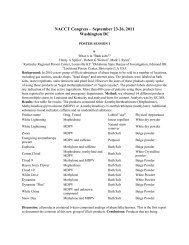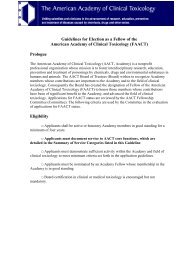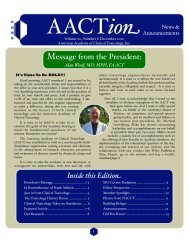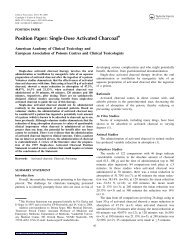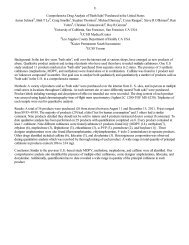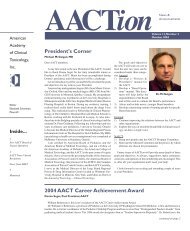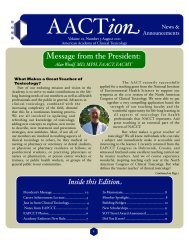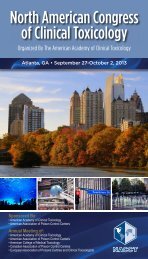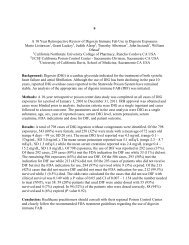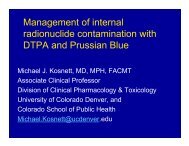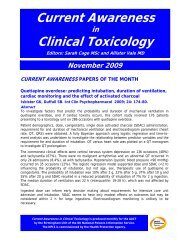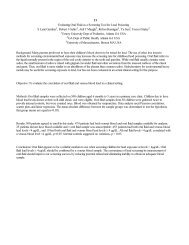Posters IV - The American Academy of Clinical Toxicology
Posters IV - The American Academy of Clinical Toxicology
Posters IV - The American Academy of Clinical Toxicology
You also want an ePaper? Increase the reach of your titles
YUMPU automatically turns print PDFs into web optimized ePapers that Google loves.
291<br />
Poisonings Associated with Medication Organizers<br />
Rita Mrvos 1 , Edward P Krenzelok 1<br />
1 University <strong>of</strong> Pittsburgh Medical Center, Pittsburgh PA USA<br />
Background: Pill organizer container usage is becoming more prevalent in homes. <strong>The</strong> majority <strong>of</strong> these<br />
organizers are not child resistant and targeted for use in the elderly population to encourage compliance<br />
with medication regimes. To determine the prevalence <strong>of</strong> exposures involving these types <strong>of</strong> containers all<br />
exposure calls over a 4 month period involving pill organizers reported to a RPIC were reviewed.<br />
Methods: All poisoning exposure calls received at a RPIC were documented in the usual manner. If<br />
during the interview the caller mentioned that the medication was in a pill organizer when the exposure<br />
occurred, the information was documented on the chart. No further questioning about the container was<br />
done. <strong>The</strong> case was then tagged for review. Using Crystal Reports the medical record database was<br />
queried for these tagged cases and data collection included age, gender, exposure site, patient flow,<br />
hospital flow, outcome and substance(s). <strong>The</strong> data was analyzed using descriptive statistics. Results: 75<br />
exposures involving pill organizers were identified during the 4 month study period. 24 (32%) were adults<br />
and 51 (68%) were children less 6 years <strong>of</strong> age. Multiple medications were involved in 47 (62.6%) <strong>of</strong> the<br />
exposures including 1 case with 10 substances, 12 patients were exposed to 3 different medications and 19<br />
to 2 different meds. 28 <strong>of</strong> the adults (33%) were treated in a health care facility. 2 were admitted to a<br />
critical care unit, 2 were admitted to a non critical care unit, 3 were treated and released and 1 case was<br />
lost to f/u. Of the 51 pediatric exposures, 19(37%) required evaluation in a health care facility. Of these,<br />
13 (68%) were treated and released from the emergency department, 1 (5%) was admitted to critical care,<br />
3 (16%) were admitted to a non critical care unit and 2 (11%) cases were lost to follow-up. Conclusion:<br />
Although improved medication compliance in an aging population is highly desirable, many factors play a<br />
role in medication safety including pill organizers. Education as to the proper way to take, administer and<br />
store medications remains a vital part <strong>of</strong> ongoing education.<br />
292<br />
Inconsistencies in non-pharmaceutical commercial product labels<br />
Lee Cantrell 1 , Sean Nordt 2 , Jamey Krauss 3<br />
1 California Poison Control System- San Diego Division, CA USC Keck School <strong>of</strong> Medicine, CA<br />
3 Univ. <strong>of</strong> Calif. San Francisco School <strong>of</strong> Pharmacy, CA<br />
Background: Human exposures to non-pharmaceutical commercial products occur frequently. Many<br />
product labels contain instructions for managing unintentional exposures, however the information<br />
provided varies considerably. US government regulatory agencies do not specifically mandate the type or<br />
location <strong>of</strong> information that must be contained in case <strong>of</strong> accidental exposure. <strong>The</strong> AAPCC has published<br />
guidelines for industries to use the national toll-free poison center (PC) telephone number, however there<br />
is no published data to determine if companies are adhering to these guidelines. While other authors have<br />
described the inadequate quality <strong>of</strong> product first aid instructions, the purpose <strong>of</strong> this study was to<br />
characterize the type and physical location <strong>of</strong> first aid instructions and consumer referral information.<br />
Methods:A random, convenience sample <strong>of</strong> commercial product label information was obtained from a<br />
variety <strong>of</strong> local retail stores over a 6 month period. Twelve common non-pharmaceutical product<br />
categories with large numbers <strong>of</strong> annual human exposures were identified from NPDS data. A minimum<br />
<strong>of</strong> 10 unique products for each category were required. <strong>The</strong> following information was collected on a<br />
standardized Excel spreadsheet: product name and manufacturer, location on container, presence and type



